What Are The Different Types Of Crankbaits? (Explained For Beginners)
UPDATED 03 NOVEMBER 2023
by Robert Ceran
Crankbaits are among the most popular fishing lures on the market, and consistently produce fish for beginners and experienced anglers alike.
But crankbait fishing can be a little challenging for beginners because cranks come in such a wide variety of different types, sizes, and shapes (not to mention colors, which are even more diverse).

In order to make it easier for you to get started with crankbait fishing, this article walks you the main types of crankbaits, their key characteristics, and how you can use them to catch more fish.
Crankbait types chart
| Type of crankbait | Image | Lip shape & size | Diving depth (feet) |
|---|---|---|---|
| Square bill crankbait |  | Square lip | 2' to 5' |
| Round bill crankbait |  | Round lip | 2' to 30' (depending on size & angle of lip) |
| Lipless crankbait |  | No lip | 10' to 40' |
| Shallow diving crankbait |  | Small lip | 2' to 5' |
| Medium diving crankbait |  | Medium size lip | 5' to 15' |
| Deep diving crankbait |  | Big lip | 12' to 30' |
The chart above compares the main types of crankbaits, as well as their lip shape and diving depth.
Keep in mind that there are a lot of additional variations that we will cover in more detail below.
What are the different types of crankbaits?
The three main types of crankbaits are:
- Square bill crankbaits
- Round bill crankbaits
- Lipless crankbaits
The list above classifies crankbait types based on their lip shape. But another way to look at crankbait types is based on their diving behavior, which goes as follows:
- Shallow diving crankbaits
- Medium diving crankbaits
- Deep diving crankbaits
Both of these crankbait classifications are useful in order to choose the right crankbait for the job at hand, and we’ll cover both of them in more detail below.
Jerkbait vs crankbait – what’s the difference?
The main difference between jerkbaits and crankbaits is that jerkbaits are longer and thinner, and come with 3 treble hooks instead of 2. Crankbaits, on the other hand, tend to be shorter and stouter, and only have 2 treble hooks.
And while this seems like a small difference, the long and thin body of jerkbaits gives them a much tighter wiggling action in the water compared to the wider wobbling action of crankbaits.
Jerkbaits also suspend with more balance than crankbaits due to their 3 treble hooks, and this can be an advantage for some crankbait fishing applications if you want to pause the lure regularly during retrieval.
Swimbait vs crankbait
The main difference between hard swimbaits and crankbaits is that swimbaits are usually much more realistic imitations of a specific baitfish species, while crankbaits tend to be much less realistic.
In addition, most swimbaits come with multiple joints and don’t have a lip, which gives them a different swimming action in the water compared to crankbaits.
Crankbait types based on diving behavior
A very useful way to classify different types of crankbaits is based on how deep they dive in the water.
Let’s take a closer look at these:
Shallow diving crankbait
Shallow diving crankbaits are designed to dive to a depth of 2 to 5 feet. They are almost always floating and come with a relatively small bill positioned at an angle to their long axis.
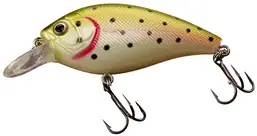
You can get shallow diving crankbaits with either a square bill or a round bill. Square bills are best for fishing in and around cover, while round bills are better for open water. These are the best crankbait types for catching bass in shallow water.
Medium diving crankbait
Medium diving crankbaits are designed to dive to a depth of 5 to 15 feet, and usually come with a round bill that is slightly larger than that of shallow diving crankbaits.
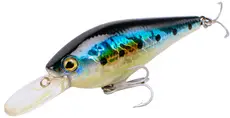
They are great for targeting bass or walleye holding in medium depth areas close to the shallows. In the case of bass, this is often the case in prespawn, when bass get ready to move into the shallows for the spawn.
Deep diving crankbait
Deep diving crankbaits are designed to dive to depths of 15 to 25 feet, and come with the largest bill size. The size and the angle of their bill causes them to dive downwards at a steep angle during retrieval.
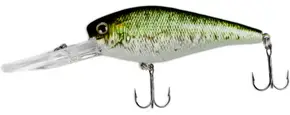
In addition to their deep diving behavior, these crankbaits are usually built to sink in the water, and some anglers add extra weights to them, to make them sink faster.
This type of crankbait is ideal during winter as well as peak summer, when bass retreat to deeper water.
Crankbait lip types
The easiest way to identify what kind of crankbait you’re looking at is by its lip types. Crankbait lip type determines the diving behavior of the crankbait when you retrieve it, and is the best indicator to use for choosing the right crankbait for your purposes.
Square bill crankbaits
Square bill crankbaits are designed to deflect off of cover (such as rocks, tree trunks, or limbs) without getting snagged, which makes them ideal for bass fishing in and around heavy cover.
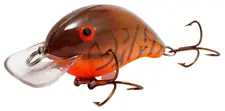
In fact, the best way to fish square bills is to let them bounce off cover as they go along, since that often triggers strikes from bass. If the crankbait does get snagged on cover, a trick that often helps is to pause your retrieve, and let it float free.
Round bill crankbait
Round bill crankbaits are ideal for diving deep into the water, and so all deep diving crankbaits come with a round bill shape. On the other hand, round bills are not as good at deflecting when they bump into cover, which means you need to be more careful to avoid getting them snagged.
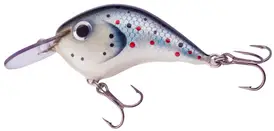
Lipless crankbait
As implied by their name, lipless crankbaits come without a lip, and are designed to be fished deep and slow. And since they don’t have a lip, their swimming action is a very tight wiggle, which works well for deep water bass during the cold months.
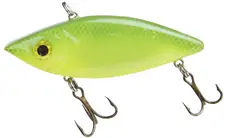
Lipless cranks are sinking crankbaits, which makes them ideal for fishing in deeper water over 10 feet.
Crankbait lip size
Crankbait lip size is directly correlated to how deep they dive in the water. The deepest diving crankbaits come with a lip that’s practically the same size as the body of the crank.
A large crankbait lip provides more resistance to the water during retrieval, and this pushes the crankbait down as it gets pulled through the water.
Crankbait lip angle
Lip angle also affects crankbait diving behavior: a small lip angle causes a crankbait to dive deeper into the water, while a big lip angle makes it dive more shallow.
Additional crankbait variations
In addition to the crankbait types discussed above, there are a number of additional variations in build that you should know about. Let’s take a close look at these below.
Flat sided crankbait
Flat sided crankbaits have a deep profile from top to bottom, but are skinny when viewed from the front or the back.
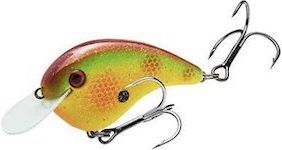
This distinctive shape gives them a tighter wiggling action than full bodied crankbaits, which looks more natural when you reel them in, and is very effective in fall and winter, when bass are chasing schools of shad.
Jointed crankbait
A jointed crankbait consists of two parts connected by a single joint, which is usually in the middle or the rear third of the crankbait.

The swimming action of a jointed crankbait has a more elastic motion to it, which looks more natural than the hard wobble of an un-jointed crankbait. However, in most cases crankbaits don’t need to be super realistic in order to catch fish, so this is just something to experiment with.
Minnow crankbait
Minnow crankbaits are longer and thinner than regular crankbaits, and are colored grey or silver to resemble a minnow.
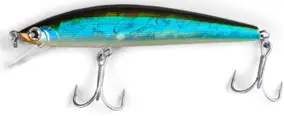
Using minnow crankbaits is a great option if you notice that the fish you’re trying to catch (bass, trout, crappie, etc.) are currently feeding on minnows.
Floating crankbait
Most shallow and medium diving crankbaits are almost always floating crankbaits, which means the only way that they can dive down in the water is with the help of their lip when you reel them in. This also means that when you pause retrieval, they will float upwards in the water, which can be a great trick to prevent a snag.
Sinking crankbait
Deep diving and lipless crankbaits are usually sinking crankbaits, which is necessary to get them down to the desired depth as fast as possible. In fact, some bass anglers (including KVD), like to add extra weights to their deep diving cranks in winter, in order to fish them as deep as possible.
Rattling crankbait
Rattling crankbaits are hollow crankbaits that have glass or metal beads inside that cause them to rattle during retrieval. This can be a great way to help bass find the crankbait in stained water, though it can also spook finicky fish, so you shouldn’t use it all the time.
What is the deepest diving crankbait?
The deepest diving crankbait is the Salmo Free Diver, which can dive down to a maximum depth of 40’ when trolled, and dives down to depths between 17’ and 30’ when thrown and retrieved.
However, many other fishing lure companies make deep diving crankbaits that can reach depths between 22’ and 27’, so you have a large selection to choose from if you want to fish crankbaits deep.
